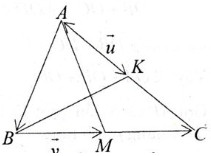Cho hình vuông ABCD, E là trung điểm của CD. Hãy phân tích \(\overrightarrow{AE}\) theo hai vectơ \(\overrightarrow{u}=\overrightarrow{AD};\overrightarrow{v}=\overrightarrow{AB}\) ?
Hãy nhập câu hỏi của bạn vào đây, nếu là tài khoản VIP, bạn sẽ được ưu tiên trả lời.

Tham khảo:

Ta có: \( \overrightarrow {AB} + \overrightarrow {AD} = \overrightarrow {AC} \) (do ABCD là hình bình hành)
\( \Rightarrow \overrightarrow {BM} = \overrightarrow {AB} + \overrightarrow {AD} = \overrightarrow {AC} \)
\( \Rightarrow \) Tứ giác ABMC là hình bình hành.
\( \Rightarrow \overrightarrow {DC} =\overrightarrow {AB} = \overrightarrow {CM} \).
\( \Rightarrow C\) là trung điểm DM.
Vậy M thuộc DC sao cho C là trung điểm DM.
Chú ý khi giải
+) Tứ giác ABCD là hình bình hành \( \Leftrightarrow \overrightarrow {AD} = \overrightarrow {BC} \)
+) ABCD là hình bình hành thì \(\overrightarrow {AB} + \overrightarrow {AD} = \overrightarrow {AC} \)

a) Ta có: \(\overrightarrow {CE} = \overrightarrow {AN} \Rightarrow CE//AN\) và \(CE = AN = ND = BM = MC\)
Suy ra \(\overrightarrow {MC} = \overrightarrow {CE} \)
+) \(\overrightarrow {NC} + \overrightarrow {MC} = \overrightarrow {NC} + \overrightarrow {CE} = \overrightarrow {NE} \)
+) ABCD là hình bình hành nên \(\overrightarrow {CD} = \overrightarrow {BA} \)
\(\overrightarrow {AM} + \overrightarrow {CD} = \overrightarrow {AM} + \overrightarrow {BA} = \overrightarrow {BM} \)
+) Ta có \(\overrightarrow {MC} = \overrightarrow {AN} \Rightarrow AMCN\) là hình bình hành nên \(\overrightarrow {NC} = \overrightarrow {AM} \)
\(\overrightarrow {AD} + \overrightarrow {NC} = \overrightarrow {AD} + \overrightarrow {AM} = \overrightarrow {AE} \) (vì AMED là hình bình hành)
b) Ta có:
+) \(\overrightarrow {NC} - \overrightarrow {MC} = \overrightarrow {NC} + \overrightarrow {CM} = \overrightarrow {NM} \)
+) \(\overrightarrow {AC} - \overrightarrow {BC} = \overrightarrow {AC} + \overrightarrow {CB} = \overrightarrow {AB} \)
+) \(\overrightarrow {AB} - \overrightarrow {ME} = \overrightarrow {AB} - \overrightarrow {AD} = \overrightarrow {AB} + \overrightarrow {DA} = \overrightarrow {DB} \)
c) Ta có:
\(\overrightarrow {AM} + \overrightarrow {AN} = \overrightarrow {AM} + \overrightarrow {MC} = \overrightarrow {AC} \)
Áp dụng quy tắc hình bình hành vào hình bình hành ABCD ta có
\(\overrightarrow {AB} + \overrightarrow {AD} = \overrightarrow {AC} \)
Từ đó suy ra \(\overrightarrow {AM} + \overrightarrow {AN} = \overrightarrow {AB} + \overrightarrow {AD} \) (đpcm)

a.
Do M là trung điểm OB \(\Rightarrow\overrightarrow{OM}=\dfrac{1}{2}\overrightarrow{OB}\)
\(\Rightarrow\overrightarrow{AM}=\overrightarrow{AO}+\overrightarrow{OM}=-\overrightarrow{OA}+\dfrac{1}{2}\overrightarrow{OB}\)
b.
Do N là trung điểm OC \(\Rightarrow\overrightarrow{ON}=\dfrac{1}{2}\overrightarrow{OC}\)
\(\Rightarrow\overrightarrow{BN}=\overrightarrow{BO}+\overrightarrow{ON}=-\overrightarrow{OB}+\dfrac{1}{2}\overrightarrow{OC}\)
\(\overrightarrow{MN}=\overrightarrow{MO}+\overrightarrow{ON}=-\overrightarrow{OM}+\overrightarrow{ON}=-\dfrac{1}{2}\overrightarrow{OB}+\dfrac{1}{2}\overrightarrow{OC}\)


Gọi G là giao điểm của AK, BM thì G là trọng tâm của tam giác.
Ta có  =
= 
 =>
=>  =
=

 = -
= - = -
= -
 = -
= -

Theo quy tắc 3 điểm đối với tổng vec tơ:
 =
=  +
+ =>
=>  =
= 
 -
- 
 =
=  (
( -
-  ).
).
AK là trung tuyến thuộc cạnh BC nên
 +
+  = 2
= 2 =>
=> 
 -
- 
 +
+ = 2
= 2
Từ đây ta có  =
= 
 +
+
 =>
=>  = -
= -
 -
- 
 .
.
BM là trung tuyến thuộc đỉnh B nên
 +
+  = 2
= 2 => -
=> -  +
+ = 2
= 2
=>  =
= 
 +
+
 .
.

Từ M kẻ đường thẳng song song với AB, cắt AD tại E.
Khi đó tứ giác ABME là hình bình hành.
Do đó: \(\overrightarrow {AM} = \overrightarrow {AB} + \overrightarrow {AE} \).
Dễ thấy: \(AE = BM = \frac{1}{2}BC = \frac{1}{2}AD\)
\( \Rightarrow \overrightarrow {AE} = \frac{1}{2}\overrightarrow {AD} \)
\( \Rightarrow \overrightarrow {AM} = \overrightarrow {AB} + \frac{1}{2}\overrightarrow {AD} \)
Vậy \(\overrightarrow {AM} = \overrightarrow {AB} + \frac{1}{2}\overrightarrow {AD} \)
Chú ý khi giải
+) Dựng hình hình hành sao cho đường chéo là vecto cần biểu thị, 2 cạnh của nó song song với giá của hai vecto đang biểu thị theo.

Dễ thấy:
\(AD = BC\) nhưng \(AD\) và \(BC\) không song song với nhau. Do đó hai vectơ \(\overrightarrow {AD} \) và \(\overrightarrow {BC} \) không bằng nhau.
\(CD > AB\) do đó hai vectơ \(\overrightarrow {AB} \) và \(\overrightarrow {CD} \) không bằng nhau.
\(AC\) và \(BD\) không song song với nhau. Do đó hai vectơ \(\overrightarrow {AC} \) và \(\overrightarrow {BD} \) không bằng nhau.

a) Nếu ABCD là hình bình hành thì \(\overrightarrow {AB} + \overrightarrow {AD} = \overrightarrow {AC} \)
Với E là điểm bất kì, ta có: \(\overrightarrow {AB} + \overrightarrow {AD} + \overrightarrow {CE} = \overrightarrow {AC} + \overrightarrow {CE} = \overrightarrow {AE} \)
b) Nếu I là trung điểm của đoạn thẳng AB thì \(\overrightarrow {MA} + \overrightarrow {MB} = 2\overrightarrow {MI} \).
Với hai điểm bất kì M, N ta có:
\(\overrightarrow {MA} + \overrightarrow {MB} + 2\overrightarrow {IN} = 2\overrightarrow {MI} + 2\overrightarrow {IN} = 2\left( {\overrightarrow {MI} + \overrightarrow {IN} } \right) = 2\overrightarrow {MN} .\)
c) Nếu G là trọng tâm của tam giác ABC thì \(\overrightarrow {MA} + \overrightarrow {MB} + \overrightarrow {MC} = 3\overrightarrow {MG} \)
Với hai điểm bất kì M, N ta có:
\(\overrightarrow {MA} + \overrightarrow {MB} + \overrightarrow {MC} - 3\overrightarrow {MN} = 3\overrightarrow {MG} - 3\overrightarrow {MN} = 3\left( {\overrightarrow {MG} - \overrightarrow {MN} } \right) = 3\overrightarrow {NG} \).
Theo tính chất trung điểm
\(\overrightarrow{AE}=\dfrac{1}{2}\left(\overrightarrow{AD}+\overrightarrow{AC}\right)=\dfrac{1}{2}\overrightarrow{AD}+\dfrac{1}{2}\overrightarrow{AC}\)\(=\dfrac{1}{2}\overrightarrow{AD}+\dfrac{1}{2}\left(\overrightarrow{AB}+\overrightarrow{BC}\right)\)\(=\dfrac{1}{2}\overrightarrow{AD}+\dfrac{1}{2}\left(\overrightarrow{AB}+\overrightarrow{AD}\right)=\overrightarrow{AD}+\dfrac{1}{2}\overrightarrow{AB}=\overrightarrow{u}+\dfrac{1}{2}\overrightarrow{v}\).